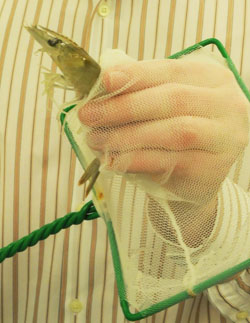Iowa State University-based research leads to jumbo shrimp agreement
01-18-11
Contacts:
Dr. Hank Harris, Animal Science, 515-294-1664, hank.sirrah@gmail.com
Joel Harris, Harrisvaccines, 515-460-2430, joel.sirrah@gmail.com
Dan Kuester, News Service, 515-294-0704, kuester@iastate.edu
Iowa State University-based research leads to jumbo shrimp agreement
AMES, Iowa - Iowa State University-based shrimp research has led to an international licensing and marketing agreement for two vaccines to be used in shrimp farming around the world.
Hank Harris, professor in animal science, started working on shrimp vaccines in 2000 and has now reached an agreement with one of Asia's dominant aquaculture producers for collaborative research support and marketing of the products resulting from the research throughout Asia and major shrimp-producing countries in the Americas.

Currently, about 70 percent of the world's farmed shrimp supply is produced in Asia.
Shrimp farming has experienced rapid growth over the past 30 years, according to Joel Harris, chief marketing officer of Harrisvaccines, the Ames company that is helping develop the vaccine.
Despite the growth, the industry has suffered billions of dollars in losses due to viral diseases. The two most devastating are white spot syndrome virus (WSSV) and infectious myonecrosis virus (IMNV). Both are being targeted by Hank Harris' vaccine development program.
Hank Harris has worked for 30 years developing swine vaccines, and recently developed a vaccine to prevent pigs from getting the H1N1 virus.
Joel Harris said that working with shrimp is different in many ways.
"Because they are invertebrates, they have a completely different immune system from swine and all other vertebrate livestock," said Joel Harris. "Invertebrates, like shrimp, are generally believed to be incapable of acquiring immunity, but we have discovered strategies to induce a similar effect in shrimp."
The research has led to effective vaccines, but the current challenge is how to vaccinate individual animals.
"Consider that a typical shrimp production pond is stocked with 500,000 post larvae about the size of mosquitoes. It's kind of tough for the farmer to inject each animal," said Hank Harris.
 Hank and
Joel Harris
Hank and
Joel Harris
"Right now, we're looking at delivering the vaccine orally in the feed through a pellet they would eat, or immersing the post larvae in [the vaccine] in the water," he said.
With the help of the new agreement, Hank Harris thinks he will have figured out a delivery method and will have an economically viable vaccine for use in commercial production within six months to a year.
The United States is the world's largest importer of shrimp, valued at around $3 billion annually, according to the United States Department of Agriculture. Americans consume more than four pounds per year, and in 2002 shrimp became the most popular seafood overtaking canned tuna.
Most of the shrimp consumed in the United States is imported from Thailand, Indonesia, Vietnam and China.
-30-